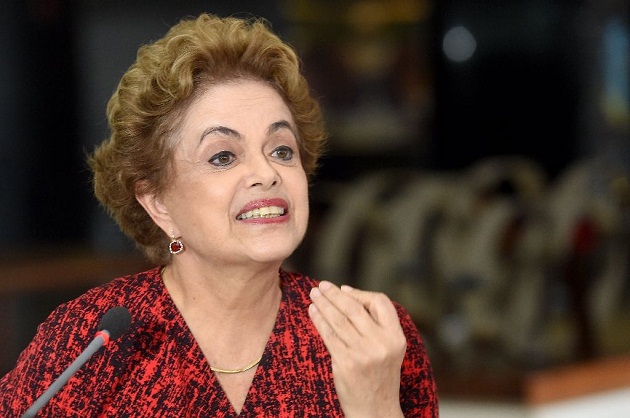Rio de Janeiro, Brazil | AFP |
When she was being tortured under Brazil’s military dictatorship, Dilma Rousseff could never have imagined becoming the country’s first female president.
But four decades on from those dark days in 1970, when Rousseff belonged to a violent Marxist underground group, she did indeed rise to the top — only to face impeachment less than a year into her second term.
Impeachment proceedings launched in October enter their crucial phase Monday, with a vote in Congress’ lower house commission.
Although non-binding, the decision sets the tone for a critical vote in about a week’s time in the full house on whether to send Rousseff to trial.
Brazil’s 68-year-old “iron lady” has put up a serious fight, trying frantically to repair a coalition left in tatters by the defection of the country’s largest party, the PMDB.

The impeachment charges center on her government’s allegedly illegal juggling of accounts to cover budget holes.
But momentum is also fueled by anger across across Latin America’s biggest country over steep recession, corruption and the government’s inability to deal with Congress.
Whether that’s fair or not, Rousseff has already been condemned by public opinion, her government’s popularity plummeting to around 10 percent since her narrow 2014 re-election win against business-world favorite Aecio Neves.
Some critics attack Rousseff for lacking charisma. Others go further, calling her the classic accidental president, a politician who doesn’t like politicking.
But as Rousseff herself has pointed out, torture steeled her for tough times.
“I have come up against hugely difficult situations in my life, including attacks which took me to the limit physically,” she said. “Nothing knocked me off my stride.”
Cancer battle
Rousseff came to power in a 2010 election as the handpicked Workers’ Party candidate to succeed hugely popular president Luiz Inacio Lula da Silva.
Whether as Lula’s chief of staff or energy minister, she won a reputation for laser-like attention to detail and ability to master the most minute of policy points — a talent she is said to have carried on into her own cabinet meetings.
Supporters say there’s also a warmer side to the leader popularly known by her first name Dilma.
Twice married, Rousseff has a daughter, Paula, from a 30-year relationship with ex-husband, fellow leftist militant Carlos de Araujo.
At Lula’s prompting during her reelection campaign she learned to open up a little, for example once confessing to escaping the presidential palace on the back of a friend’s Harley-Davidson and cruising through the streets of Brasilia incognito.
“People always say about women in power that they’re hard, managerial. But Dilma is a person with a great sense of humor, fun, extremely caring and generous,” said Ieda Akselrud de Seixas, who was jailed with Rousseff in the 1970s.
Rousseff also tapped into a national obsession for plastic surgery, getting her teeth whitened, hair redone and lifting wrinkles from her face.
The relatively fresh look was in contrast to the visible toll exacted during her successful battle against lymphatic cancer that was first diagnosed in 2009. At one point, she had to wear a wig to cover hair loss from chemotherapy.
She has since made a complete recovery, doctors say.
‘High priestess of subversion’
Born December 14, 1947 to a Brazilian mother and Bulgarian businessman father, Rousseff grew up comfortably middle-class in the southeastern city of Belo Horizonte.
She cut her political teeth as a Marxist militant opposed to the 1964-1985 dictatorship and in January 1970 was arrested and sentenced to prison for membership of a group responsible for murders and bank robberies.
Rousseff’s actual exploits during her time in the Revolutionary Armed Vanguard Palmares group remain shrouded in rumor, claims, denials and accusations of exaggeration, but most reports agree that she played more a support role than taking part in violence.
Nevertheless, the judge who found her guilty dubbed her the “high priestess of subversion,” journalist Ricardo Amaral wrote in a biography. A photo in the book shows a bespectacled Rousseff aged just 22 staring defiantly at the court.
After nearly three years behind bars, during which she says she was subjected to repeated bouts of torture, including electric shocks, Rousseff was released at the end of 1972.
She took a legal political path from then on, helping found the Democratic Labor Party (PDT) in 1979 and eventually switching to Lula’s Workers’ Party in 2000.
From there, she made rapid progress into the country’s most powerful positions.
When Lula was first elected president in 2003, he named Rousseff his energy minister and then, in 2005, his cabinet chief.
As chairwoman of Petrobras from 2003 to 2010, Rousseff was at the tiller of the country’s biggest energy company — a record that has come back to haunt her with the revelation of massive corruption at the firm, although no incidents specifically sticking to her.
Lula, whose own legacy is now threatened by Petrobras-related corruption charges, said he always knew Rousseff was special.
“She came here with her little computer,” Lula said after appointing Rousseff to her first cabinet post. “She started to talk and I felt something different in her.”
 The Independent Uganda: You get the Truth we Pay the Price
The Independent Uganda: You get the Truth we Pay the Price



